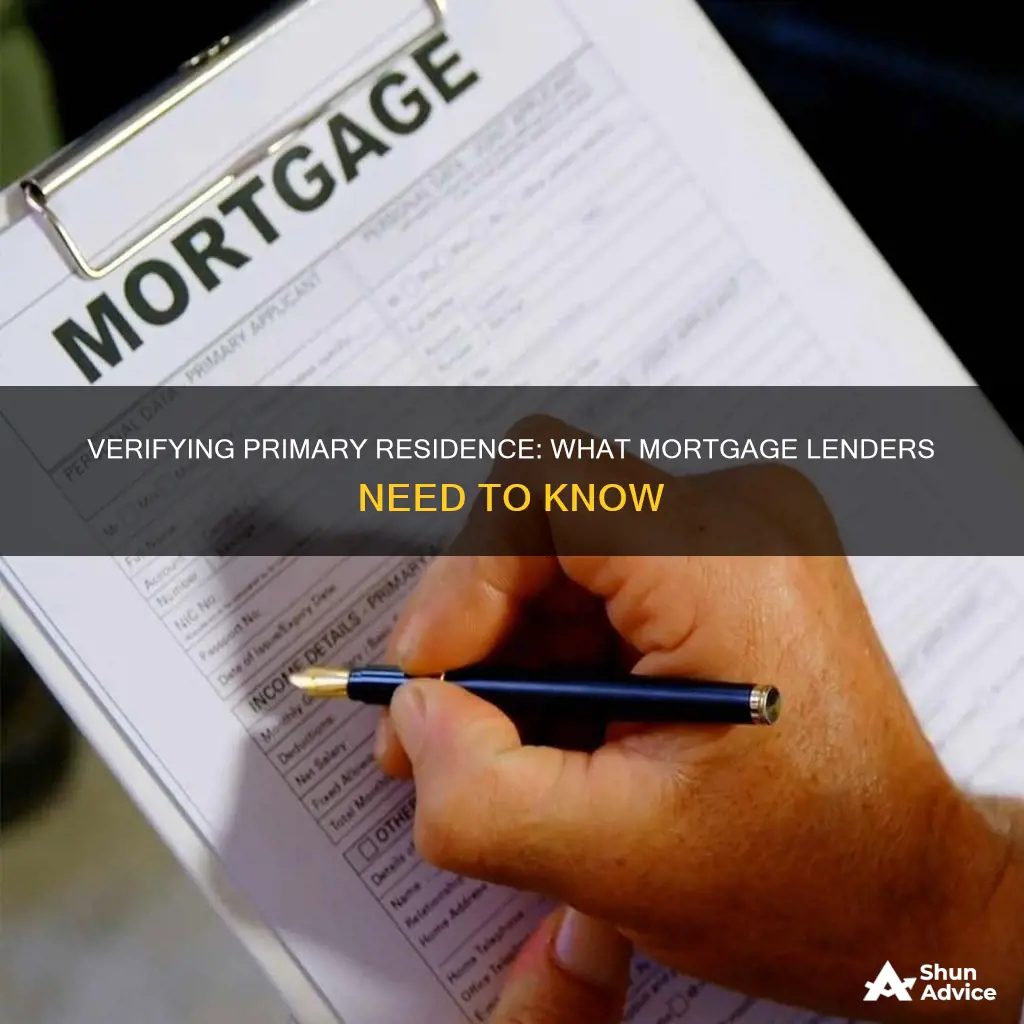
When applying for a mortgage, it is important to be transparent with your lender about the type of property you are financing. A primary residence is the principal or main home you live in for most of the year. It is important to verify your primary residence to qualify for better terms, lower interest rates, and certain tax benefits. The Internal Revenue Service (IRS) sets clear guidance to help determine if your home qualifies as a primary residence. The IRS can confirm primary residence ownership and usage by reviewing tax returns, requesting documentation such as utility bills and voter registration records, checking public records, and consulting third-party sources.
| Characteristics | Values |
|---|---|
| Definition | The principal or main home you live in for most of the year |
| Classification | Primary residence, secondary residence, or investment property |
| Verification | Tax returns, mortgage statements, utility bills, voter registration records, public records, third-party sources, on-site inspection |
| Benefits | Lower mortgage rates, tax benefits, mortgage interest deduction, property tax deductions, capital gains exclusion |
| Rules | Must occupy by a certain date after closing, live in for the majority of the year, live in for at least one year after closing |
| Fraud | Lying about owner occupancy is a type of mortgage fraud and can be prosecuted |
What You'll Learn

Primary residence requirements
A primary residence is the principal or main home that an individual or family lives in for most of the year. It is the address listed on official documents such as a driver's license, tax returns, and voter registration card. A primary residence can be any type of dwelling, including a single-family home, an apartment, or a condominium.
When applying for a mortgage, it is important to inform the lender if the property will be the primary residence, as this will impact the terms of the loan and the interest rate offered. Lenders consider primary residence mortgages to be less risky and offer lower interest rates compared to other types of properties. The interest paid on a primary residence mortgage may also be tax-deductible, and the property may qualify for income tax benefits.
To verify primary residence status, lenders use standards set by the Internal Revenue Service (IRS). These standards include reviewing official documents such as tax returns, mortgage statements, utility bills, and voter registration records. The IRS may also check public records, consult third-party sources, or conduct an on-site inspection of the property.
It is important to note that a primary residence cannot be a vacation home, an investment property, or a rental property. If an individual owns multiple homes, the IRS will determine the primary residence based on the address listed on official documents, the proximity to work or other frequently visited locations, and the amount of time spent at each property.
Wall Street's Mortgage Business: How It Works
You may want to see also

Mortgage interest deductions
The mortgage interest deduction is one of several homeowner tax deductions provided by the Internal Revenue Service (IRS). It is an itemized deduction, meaning that to claim it, homeowners must itemize their deductions using Schedule A (Form 1040). This requires filling out additional forms and submitting records, receipts, and other documents that validate the deductions. Homeowners will need a Form 1098 from their mortgage lender or servicer, which details the amount of mortgage interest and points paid during the tax year.
The Tax Cuts and Jobs Act (TCJA) of 2017 lowered the mortgage deduction limit from $1 million to $750,000 for the 2018 tax year. For the 2024 tax year, married couples filing jointly, single filers, and heads of households can deduct up to $750,000, while married taxpayers filing separately can deduct up to $375,000 each. It is important to note that the standard deduction does not require additional forms or proof of deductions and may be more advantageous for some taxpayers.
While the MID has been criticised for redistributing resources from lower-income renters to higher-income homeowners, some studies suggest that renters may actually benefit from these policies in general equilibrium. This is because the reduction in rental demand leads to a decrease in market rents, benefiting renters who spend a significant portion of their income on housing. Additionally, the MID promotes homeownership, which is a cornerstone of economic policy in the United States and many other countries.
Mortgages: Primary Residence Determinants and Their Impact
You may want to see also

Tax benefits
The classification of a property as a primary residence, a secondary residence, or an investment property has significant implications for taxation and mortgage interest rates. A primary residence is considered to be the main home where an individual lives for most of the year, and it can be a single-family home, a condo, a townhouse, or an apartment.
Lower Mortgage Rates and Tax Deductions:
Primary residences typically qualify for lower mortgage rates, resulting in substantial interest savings over the life of the loan. Additionally, mortgage interest paid on a primary residence may be tax-deductible, up to a limit. Since 2018, taxpayers can deduct up to $750,000 of mortgage interest on their primary residence. This deduction can lead to significant tax savings.
Exclusion of Capital Gains Tax:
One of the most valuable tax benefits of a primary residence is the exclusion of capital gains tax when selling the property. If the home has served as the primary residence for at least two of the five years immediately preceding the sale, taxpayers may be exempt from paying capital gains tax on the profits. The IRS currently allows individuals to exclude up to $250,000 in capital gains, while married couples filing jointly can exclude up to $500,000.
Property Tax Benefits:
Primary residences often benefit from lower property taxes compared to investment or rental properties. Some states and localities offer additional property tax advantages for owner-occupied homes, further reducing the tax burden on primary residences.
Long-Term Investment Potential:
Owning a primary residence can be a sound long-term investment strategy. Home prices tend to appreciate over time, and the "2-out-of-5-years rule" allows homeowners to benefit from this appreciation without incurring capital gains tax, provided they meet the residency requirements.
It is important to note that the IRS has specific guidelines to determine a property's status as a primary residence, including reviewing tax returns, requesting documentation, and checking public records. Consulting a tax professional is advisable to navigate the tax implications of primary residence classification accurately.
Mortgages and Inflation: A Dynamic Relationship Explored
You may want to see also

Verifying a primary residence
To verify a primary residence, the IRS can use several methods, including reviewing tax returns, requesting documentation such as mortgage statements, utility bills, and voter registration records, checking public records, and consulting third-party sources like neighbors or real estate agents. Lenders also have rules and restrictions regarding primary residences, which may include occupying the residence within a certain timeframe after closing, living in the home for the majority of the year, and residing there for at least one year after closing.
When applying for a mortgage, it is crucial to inform the lender if the property will be your primary residence. This is because the type of property (primary residence, second home, or investment property) impacts the mortgage rate offered. Primary residences typically qualify for lower mortgage rates and certain tax benefits, such as the mortgage interest tax deduction. By informing the lender of your intention to use the property as your primary residence, you can ensure you receive the appropriate rate and terms for your loan.
Additionally, it is important to note that changing the status of a primary residence to a rental property or investment property may have tax implications. Homeowners should consult their mortgage lender and tax adviser before making such changes to understand the financial and legal consequences. Overall, verifying a primary residence is essential to ensure compliance with tax laws and to access the benefits associated with owning a primary home.

Fraud
Mortgage fraud is a rare but serious issue in the property market. It occurs when a borrower lies about whether or not a property will be owner-occupied, also known as occupancy fraud. This type of fraud is often difficult to detect, especially during the origination of the loan.
The borrower may claim that the property will be their primary residence to obtain more favourable rates, as mortgage rates are typically lower for primary residences. They may then convert it into a rental property, which has higher interest rates. In some cases, the borrower never intended to occupy the property and planned to rent it out from the beginning.
Lenders and the IRS have rules and restrictions in place to prevent occupancy fraud. For example, the IRS requires that a primary residence be the home where the owner lives for the majority of the year and is used as their permanent address on official documents. Lenders may also require the owner to occupy the residence by a certain date after closing, often within 60 days.
The penalties for committing occupancy fraud can be severe. The lender may recall the loan or foreclose on the property. The offender can be investigated by the FBI and, if found guilty of multiple instances of fraud, may be fined thousands of dollars. Committing occupancy fraud can also make it difficult to obtain mortgages on new properties in the future.
To detect occupancy fraud, lenders may review tax returns, mortgage statements, utility bills, voter registration records, public records, and even consult third-party sources such as neighbours or real estate agents.
It is important to note that there are legitimate cases where a homeowner may need to rent out their primary residence shortly after purchase. For example, if their employment situation requires them to move elsewhere, or if they are getting married and no longer need the property as their primary residence. In these cases, it is essential to discuss the change in circumstances with the mortgage servicing company and tax adviser to avoid any allegations of fraud.
Frequently asked questions
A primary residence is the principal or main home you live in for most of the year. It is usually the address listed on your driver's license, tax returns, and other official government documents.
Before applying for a mortgage, it is important to understand how the home you are buying is classified. Lenders use standards set by the Internal Revenue Service (IRS) to ensure a home is used as a primary residence. These include verifying the address on your driver's license, voter registration card, and federal and state tax returns. Lenders may also request documentation such as utility bills, mortgage statements, and voter registration records.
A primary residence comes with better terms, lower interest rates, and certain tax benefits. Primary homeowners may be eligible for a mortgage interest deduction on their federal income taxes, which can result in significant tax savings.







